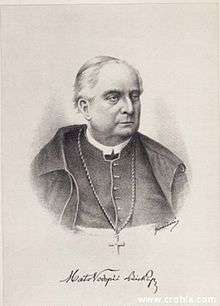Mato Vodopić
Mato Vodopić (Serbian Cyrillic: Мато Водопић; Dubrovnik, 13 December 1816 - 13 March 1893) was a prelate of the Catholic Church who served as bishop of Dubrovnik from 3 July 1882 until his death in 1893. He wrote poems for some special occasions, and was a storyteller and collector of folk ballads. He considered himself as catholic Serb,[1][2] and was a fierce supporter of a Serb and Yugoslav unification.
Mato Vodopić | |
|---|---|
 | |
| Born | 13 December 1816 Dubrovnik, Austrian Empire (modern Croatia) |
| Died | 13 March 1893 (aged 76) Dubrovnik, Austria-Hungary (modern Croatia) |
| Occupation | Bishop of Dubrovnik and writer |
| Literary movement | Illyrian movement, Serb-Catholic movement in Dubrovnik, Yugoslav unification |
| Notable works | Marija Konavoka, Tužna Jele, Robinjica |
Biography
Mato Vodopić's family was part of lower nobility in Republic of Ragusa, with lands in Pelješac peninsula where he comes from.
After 1849 the home of the Pucić brothers became the gathering center of Dubrovnik's intelligentsia, often being attended by Mato Vodopić among others, including Medo Pucić, Niko Pucić, Antun Kaznačić and his brother Ivan August Kaznačić, Antun Paško Kazali, Mato Natali, Pero Marinović, Marin Giorgi, Bishop Frano Ucellini-Tice of Kotor, Ivo Vojnović, Frano Supilo, Milorad Medini, and Dragutin Pretner. Joining with the Serb-Catholic circle, meeting in other locations like the Šarićs' drugstore, Vodopić supported the romantic idea of uniting Dalmatia with Croatia, as well as with Serbs and Italians into one state. The life of this popular cleric represents a pattern of cultural revival activities. His first work, the novel Maria the Canalite (Marija Konavoka), was left unfinished. It was published in parts since 1863. As interesting thing is this work was finished in cooperation of his brother Niko Vodopić, Juraj Carić and Marcel Kušar. His second work, a short novel called Tužna Jele, was from 1868. This work was very popular among Dubrovnikans and Konavleans (many times played on Dubrovačke ljetnje igre or Dubrovnik's Summer Games).
Mato's third work, unfinished like the first, Na doborskijeh razvalinah, was published in its finished form in 1881.
Vodopić's fourth book is a novel entitled Đenevrija, a story from the old Dubrovnik's suburb of Pile. Its manuscript was discovered only after Vodopić's death. Vice Medini and Niko Vodopić found it among Mato's personal belongings.
References
- Arsić, Irena (2017). "The culture of Catholic Serbs from Dubrovnik in contemporary Croatian historography". Faculty of Philosophy, Department for Serbian and comperative literature, University of Niš: 11–12.
- Slavík, Daniel (2016). Vědomí vlastní svébytnosti u Srbů z Dalmácie a rozvoj srbské státní (PDF). Prague, Czechia: Univerzita Karlova, Filozofická fakulta. p. 94. Retrieved 19 October 2019.